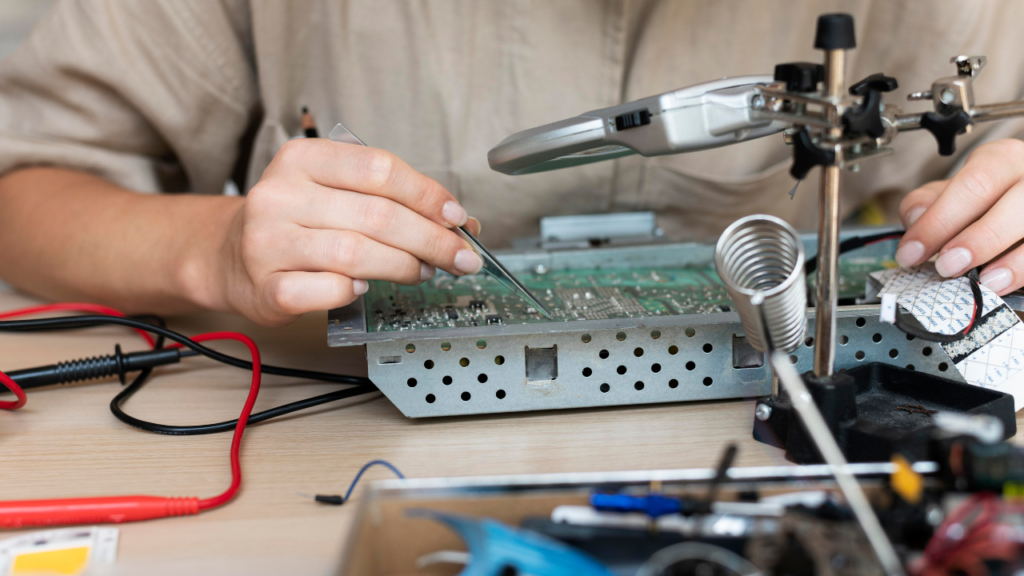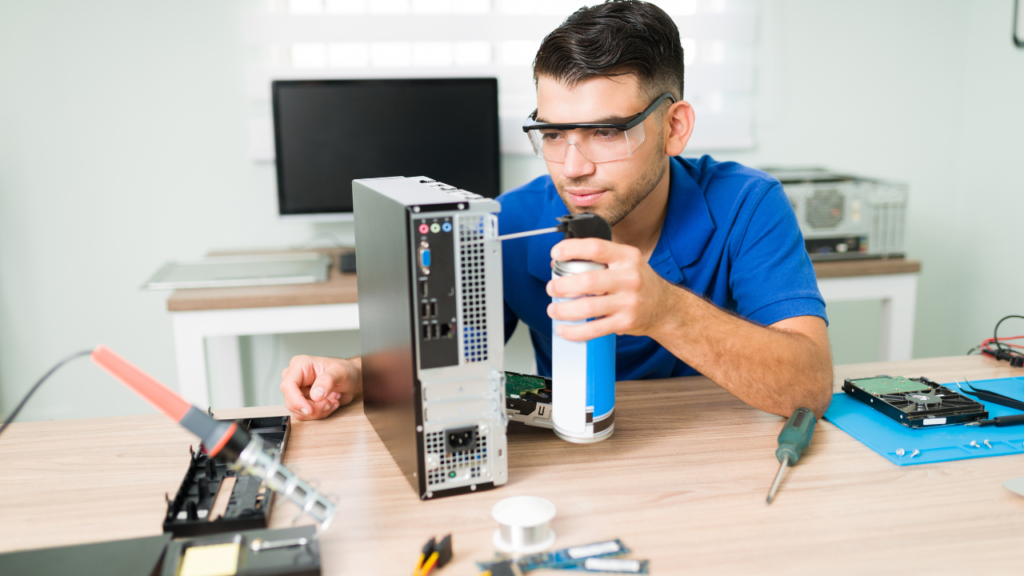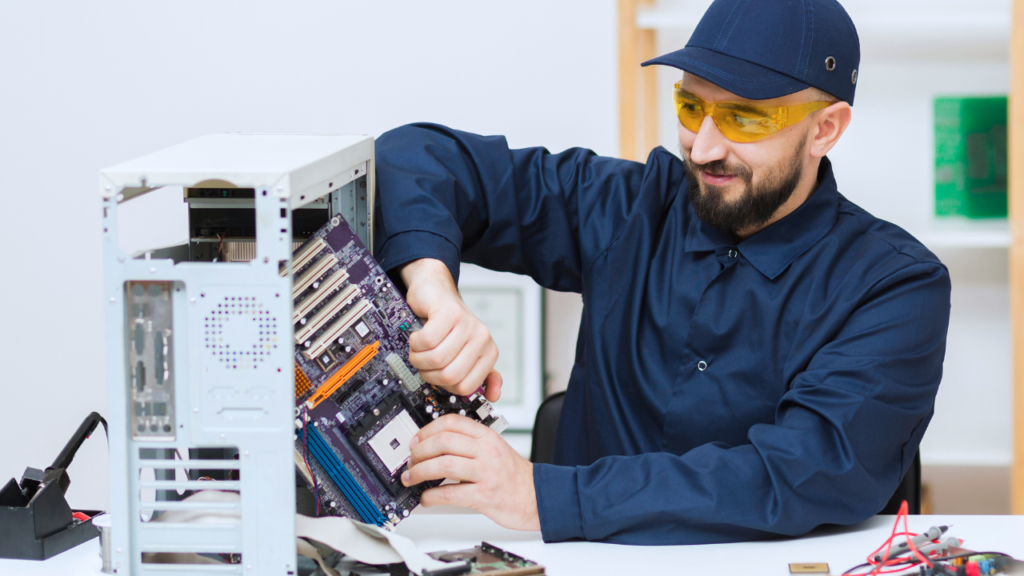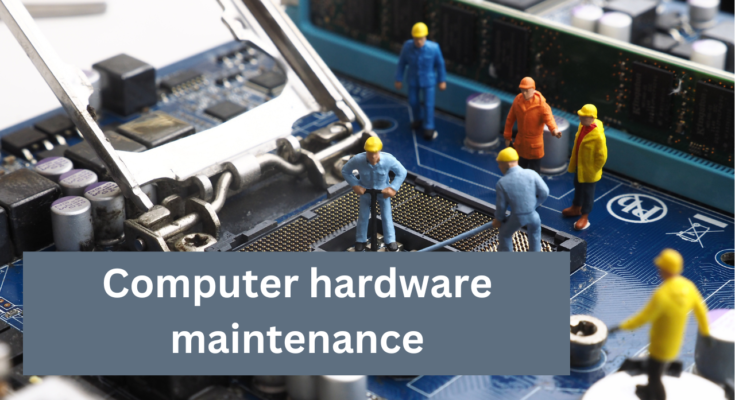6 tips of Computer hardware maintenance:
Computer hardware maintenance is a crucial aspect of improving a computer’s performance. It involves auditing, upgrading, and maintaining physical components like the keyboard, CD drives, hard disk, battery, and other peripherals. With basic Computer hardware maintenance, computers typically last between five to eight years, but can last even longer with regular preventive maintenance. Computer hardware maintenance involves caring for components such as the hard disk, battery, and other peripherals. Regular hardware preventative maintenance can extend the lifespan of a computer, ensuring optimal performance and preventing errors and faulty components.

What is Computer Hardware?
What parts of the hardware then require maintenance? All of a PC’s physical components are referred to as computer hardware. These elements consist of:
- Monitor
- Keyboard
- Central Processing Unit (CPU)
- Motherboard
- Hard Disk Drive (HDD)
- Optical drive (CD & DVD)
- Mouse
- Random Access Memory (RAM)
- Speakers
- Graphics card
- Sound card
- Fans
- Printer
Regular Computer hardware maintenance is crucial for the performance quality and speed of hardware parts, which may differ in design and manufacture. For instance, hard disk drives store data, but their capacity determines computer performance. Operating a low-capacity HDD may hinder optimal performance of large programs requiring sufficient storage space.
What is Computer Hardware Maintenance?
Computer hardware maintenance primarily involves cleaning, repairing, testing, and upgrading the physical components of your computer. These are the components that require inspection during Computer hardware maintenance procedures:
- CPU fan: It is important to check that the CPU fan and heatsink rotate freely and without interruption when power is turned on. Make that any lint or dust accumulations are gone.
- RAM components: if retaining clips are used, make sure the RAM memory modules are firmly mounted on the motherboard.
- Components for storage: make sure that all external and internal devices are discoverable and accurately link to the computer. For instance, loose wires may be the cause when you are unable to locate a hard disk in your computer’s configuration.
- Screws: Make certain there are no loose nuts and bolts and that every component is securely fastened in.
- Power supply: Check the AC power unit and make sure the cord of your PC is securely inserted into the output socket. Make that the DC power connectors connect as expected by looking at them as well.
- Keyboard and mouse – use compressed air dusters to blast off debris from your keyboard and mouse. Ensure the mouse works consistently and make replacements where necessary.
- Expansion cards – ensure your computer’s expansion card (also known as adapter card) is placed firmly and securely with the retainer screws.
- Cabling – analyze all cables to check for proper connectivity. Utilize ties to gather and route lines to prevent accidents. Also, label your cables for easier identification, especially if multiple devices connect to one port.
Computer hardware maintenance tips include:
- Schedule regular cleaning time. Buildup of dust and desk debris can damage keyboards and enter a processor’s fan and power unit. For dusting, a compressed air spray is the usual equipment.
- Make that the system and office are using the appropriate hardware. Using antiquated equipment might cause significant network slowness over time. Hardware should be kept dry and safe to avoid damage and data loss events like floods or breaches.
- Make sure your devices have adequate free disk space. Computers that are overly full of disk space may freeze, operate slowly, or cause other problems for users. You can maintain your device operating at peak performance and save up disk space by using off-site, cloud-based backup. You may transfer your archived files to your cloud backup account right now to make space available. To ensure that you never lose the remaining crucial business data, it’s also a good idea to employ cloud backup.
- Seek out and unplug any unlawful hardware. The cleared hardware that is utilized determines how safe a network is. For instance, admission to the barn is made possible by an illicit Wi-Fi router. An uncleared router typically lacks the firewall protections that the administration needs, so once it’s physically connected, anyone receiving the signal may access an unprotected network with ease.
- Look for overloaded electrical connections. Power strips can stop some problems temporarily but an overloaded socket could eventually start a fire. Multiple PCs on the same power line can be fried instantly with no home of repair when an electrical surge hits due to overloading a circuit.
- Identify areas where cabling is getting exposed or damaged and address it. A bad cable can slow down network traffic considerably or, at worse, cause intermittent cutoffs of signal connection.

Computer Hardware: Preventive Maintenance
Physical components are frequently inspected to make sure they are functioning as intended as part of hardware preventative maintenance. As the term implies, by carrying out planned Computer hardware maintenance processes, mistakes in the future are avoided. What then is the scope of preventative maintenance?
- Scheduling cleaning of your computer hardware
- Reviewing the condition of hardware components and replacing any problematic parts
You should take your computer’s working environment into account while doing preventative Computer hardware maintenance. Your gear’s performance may be affected by the circumstances in which you store and utilize it. To ensure peak performance and protect your equipment, abide by these recommendations:
- Ensure unrestricted airflow and do not obstruct hardware ventilation
- Maintain the room temperature and humidity levels given by your hardware’s manufacture
- Install fans and air conditioners for rooms with multiple devices to ensure optimum air circulation and cooling
Computer hardware maintenance falls into two categories; System-level maintenance and Physical-level maintenance.
1. System-Level Maintenance
To keep a computer’s RAM and hard drive in excellent operating order, system-level maintenance is essential. It involves safeguarding, maintaining, and cleaning the HDD. Updating anti-virus software often extends its useful life and keeps other hardware from being interfered with. Because RAM has an impact on CPU and HDD performance, it must be maintained. RAM may be freed up and CPU load can be decreased by routinely evaluating applications and removing any superfluous ones. Furthermore, regular RAM maintenance checks for possible malware that can be using up memory and hindering performance.
2. Physical-Level Maintenance
It’s common to ignore your computer’s physical components while looking for ways to boost hardware longevity and performance. You may rest assured that the quality of your computer will last by following easy maintenance practices like routinely cleaning your keyboard and CPU cover. When doing your cleaning procedures, be sure to use the appropriate solvent made specifically for fragile computer components.
There are tools specifically designed for cleaning your computer’s physical parts. Depending on the PC type, some may vary, but the equipment listed below works across different computer models.
- Screwdriver – To open up the casings holding your hard drive, graphics card, and CPU
- A dry-cleaning cloth – preferably made of microfiber to prevent scratches
- Thermal paste – A solution used to minimize air gaps between the CPU’s integrated heat spreader and the cooler. It helps to improve your CPU’s cooling functionality
- Compressed air duster cleaners – A moisture-free cleaner to dust off sensitive areas
- Cotton swabs – for wiping those hard-to-reach areas
Always remember to unplug your power unit before starting the Computer hardware maintenance process. If you feel maintenance is too complex or time-consuming, get in touch with professional service providers to assist you.
Why Computer hardware maintenance is Important
1. Determine Hardware Problems and Take Action Before They Get Worse
Computer hardware maintenance assists you in locating current problems and fixing them before they get more complicated and cause a system failure or data loss. Periodic maintenance also prolongs the life of hardware components and enhances performance before fresh parts need to be purchased. Increasing a piece of hardware’s lifespan and utilization reduces the cost of acquisition for the business, which helps it become more profitable.

2. Minimizes Deficiencies and Avoids Malware Dangers
Your company is vulnerable to security risks due to ill-maintained hardware as weak endpoints are readily exploited by hackers. Installing and upgrading your anti-malware program helps to prevent viruses from infecting and safeguarding your hardware.
3. Improves Performance
Defragging your hard disk drive, updating drivers, and uninstalling irrelevant software can free up RAM, this will improve system performance. In addition, defragmentation of a hard drive increases PC performance by organizing data spread across your hard drive and putting them into a lined-up fashion for faster reading and writing.
4. Optimize Software Efficiency
Make little hardware adjustments, such as switching graphics cards or freeing up RAM, to increase application performance. RAM can be freed up to improve performance for business apps that are running slowly. Furthermore, newer operating systems and other applications demand greater hardware capacity, which might include additional memory and hard drive space. Optimizing software performance requires regular hardware updates.
Prevents Security Breaches
Frequent Computer hardware maintenance improves endpoint security by thwarting ransomware and data theft by attackers. Vulnerabilities may be reduced and businesses shielded from security breaches by putting in place the proper security measures. Frequent Computer maintenance hardware lowers downtime for businesses and increases production. To avoid potential risks and preserve business continuity, it is best practice to schedule maintenance cycles rather than waiting for user complaints.

